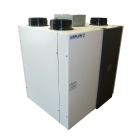Airflow adds to range of residential MVHR units

Airflow has introduced a new range of basic MVHR (mechanical ventilation with heat recovery) units for residential housing. Tunca Sekban, MVHR product manager, says, ‘MVHR in residential dwellings is becoming increasingly common, and units such our new BV range make this type of ventilation a much more realistic option for developers and social housing providers. The low running costs and high efficiency ratings mean payback times are significantly lower than several years ago when MVHR first came to the fore for ventilation.’
The Duplexvent BV300/BC300 is the smallest of the new units and can fit into a 600 mm-wide cupboard. Units can be installed vertically (BV) or horizontally (BC) as long as there is an additional condensate kit.
A backward-curved fan with EC motor can achieve a specific fan power of 0.54 W/l/s, and there are five airflow settings. Controls include summer ventilation, frost protection and built-in humidity sensor and filter-maintenance indicator.
For larger properties, the Duplexvent BV400 (pictured) has many of the same benefits as the BV units. SFP is 0.45 W/l/s, and thermal efficiency is 93%. Summer bypass is automatically controlled by built-in temperature sensors. A weekly ventilation schedule can control ventilation rate according to time of day.







